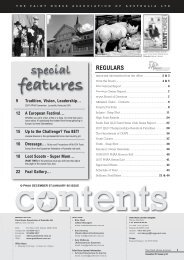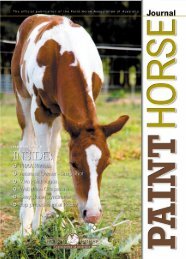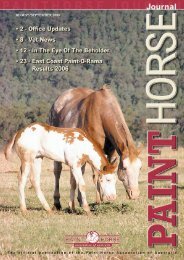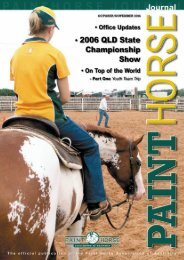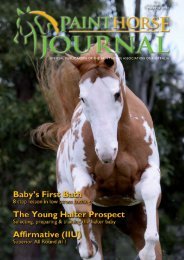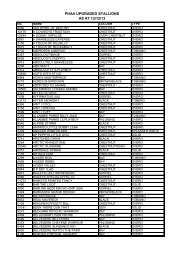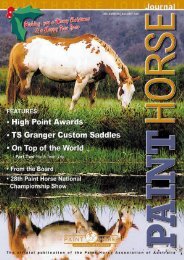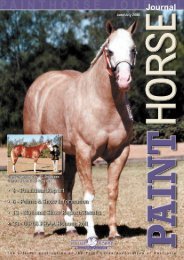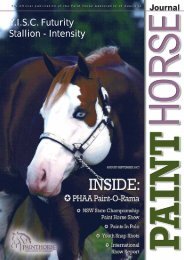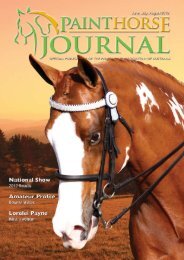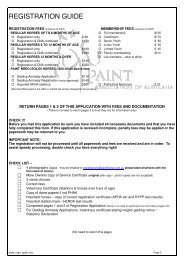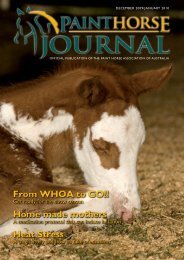Acres of Clover ⢠Photo by: Stefan & Barbara Wielebinski
Acres of Clover ⢠Photo by: Stefan & Barbara Wielebinski
Acres of Clover ⢠Photo by: Stefan & Barbara Wielebinski
Create successful ePaper yourself
Turn your PDF publications into a flip-book with our unique Google optimized e-Paper software.
PHAA - PROPOSED RULE CHANGES<br />
ii.<br />
tested to be OLWS negative.<br />
Horses applying for Splashed White registration shall be<br />
considered <strong>by</strong> the PHAA Board <strong>of</strong> Directors for such<br />
classification on a case <strong>by</strong> case basis.<br />
136. COLOURS<br />
(1) BASIC COLOURS<br />
A. BLACK: Body colour black without light areas, mane and tail<br />
black.<br />
B. BROWN/BLACK: Body colour darker than brown but not<br />
entirely fitting definition <strong>of</strong> black.<br />
C. BAY: Body colour ranging from tan through to red to reddish<br />
brown, mane and tail black, usually black on lower legs.<br />
D. BROWN: Body colour brown or black with light areas at the<br />
muzzle, eyes, flank, and inside upper legs, mane and tail<br />
black.<br />
E. CHESTNUT: Body colour reddish or copper red, mane and<br />
tail usually same colour as the body<br />
F. SORREL: Body colour reddish or copper red with flaxen<br />
mane and tail. This is caused <strong>by</strong> the recessive gene f which<br />
in the heterozygous state lightens the colour <strong>of</strong> the points.<br />
The genotype <strong>of</strong> a horse with a flaxen mane and tail is eeff,<br />
while chestnut without flaxen mane and tail is eeF-.<br />
F. LIVER CHESTNUT: Body colour dark red or ‘liver’ coloured<br />
ranging through to near chocolate, mane and tail usually<br />
same colour as the body.<br />
(2) CREAM DILUTION:<br />
A. PALOMINO: Body colour golden yellow, mane and tail white.<br />
Base colour: chestnut. Single copy <strong>of</strong> cream dilute gene.<br />
B. BUCKSKIN: Cream dilute form <strong>of</strong> bay, body colour yellowish<br />
or gold, mane and tail black; black on lower legs; lacks<br />
primitive markings.<br />
Base colour: bay. Single copy <strong>of</strong> cream dilute gene.<br />
C. SMOKY BLACK: Smoky Black is caused <strong>by</strong> a single dose <strong>of</strong><br />
the Cream gene on Black. Because the Cream gene is an<br />
incomplete dominant it does not affect black pigment<br />
physically unless it is present in homozygous form. Smoky<br />
Black horses look like regular Black horses although some<br />
may be faded so much they appear Brown or even Bay.<br />
• A genetic test showing the presence <strong>of</strong> Black (E) and<br />
Cream (Cr) is required for a horse to be registered as<br />
Smoky Black.<br />
Base colour: black. Single copy <strong>of</strong> cream dilute gene.<br />
D. CREMELLO: This is caused <strong>by</strong> the action <strong>of</strong> the dilutent gene<br />
that is acting on chestnut. This gene causes chestnut to<br />
become palomino in the heterozygous state and cremello in<br />
the homozygous state. The cremello's skin appears 'pinkish'<br />
and the eyes are amber or blue. Leg, face or body markings<br />
can be distinguished from the base colour that is a creamy<br />
<strong>of</strong>f-white. The mane and tail are extremely pale.<br />
Base colour: chestnut. Double copy <strong>of</strong> cream dilute<br />
gene.<br />
E. PERLINO: This is caused <strong>by</strong> the action <strong>of</strong> the dilutent gene<br />
that is acting on bay/brown/black. This gene causes these<br />
colours to become buckskin in the heterozygous state and<br />
perlino in the homozygous state. The coat is diluted to near<br />
white, while the dark points either remain dark or become a<br />
light rusty or chocolate shade. The skin will have minimal<br />
pigmentation and may appear 'pinkish' or grey. Leg, face or<br />
body markings will be able to be distinguished from the base<br />
colour.<br />
Base colour: bay/brown. Double copy <strong>of</strong> cream dilute<br />
gene.<br />
F. SMOKY CREAM: Smoky Cream is caused <strong>by</strong> a double dose<br />
<strong>of</strong> the Cream gene on Black which unlike Smoky Black<br />
(single dilute), affects the colour. Like all ‘double dilutes’,<br />
Smoky Creams will have pink skin and blue eyes, however<br />
there maybe a wide variation in body colour from cream<br />
coloured ranging to near white, to a light reddish, khaki, or<br />
greyish tone. Mane, tail and legs are typically slightly darker<br />
but may also be the same colour as the body. Both parents<br />
must carry the Cream gene.<br />
A genetic test showing the presence <strong>of</strong> Black (E), absence <strong>of</strong><br />
Agouti (aa) and homozygous for Cream (CrCr) is required<br />
for a horse to be registered as Smoky Cream.<br />
Base colour: black. Double copy <strong>of</strong> cream dilute gene.<br />
CREAM DILUTION TABLE<br />
No Dilution (nn) Single Dilute (nCr) Double Dilute (CrCr)<br />
Chestnut Palomino Cremello<br />
Bay Buckskin Perlino<br />
Black Smoky Black Smoky Cream<br />
(3) DUN DILUTION:<br />
A. DUN: dilute body colour <strong>of</strong> yellowish or gold, mane and tail<br />
usually black or brown, prominent dorsal stripe, legs <strong>of</strong>ten<br />
show barring and face <strong>of</strong>ten shows mask or "cob webbing".<br />
Mane usually shows lighter colour hairs along both edges <strong>of</strong><br />
neck.<br />
Base colour: bay. Single or double copy <strong>of</strong> dun dilute<br />
gene.<br />
B. RED DUN: a form <strong>of</strong> dun with body colour yellowish or flesh<br />
coloured, mane and tail usually red or reddish, prominent<br />
dorsal stripe, legs <strong>of</strong>ten show barring and face <strong>of</strong>ten shows<br />
mask or "cob webbing".<br />
Base colour: chestnut. Single or double copy <strong>of</strong> dun<br />
dilute gene.<br />
C. GRULLO: a form <strong>of</strong> dun, body colour <strong>of</strong> smoky or mouse<br />
coloured (not a mixture <strong>of</strong> black and white hairs), mane and<br />
tail usually black, prominent dorsal stripe, legs <strong>of</strong>ten show<br />
barring and face <strong>of</strong>ten shows mask or "cob webbing".<br />
Base colour: black. Single or double copy <strong>of</strong> dun dilute<br />
gene.<br />
DUN DILUTION TABLE<br />
No Dilution Dun Dilute (single or double)<br />
Chestnut<br />
Red Dun<br />
Bay<br />
Dun<br />
Black<br />
Grullo (Grulla)<br />
A Dun Zygosity test is available for the marker for the Dun<br />
dilution in Paint Horses.<br />
(4) OTHER COLOUR DILUTIONS:<br />
A. CHAMPAGNE:<br />
A champagne horse must have at least one champagne parent.<br />
A horse with one or two Champagne genes will be born with<br />
blue eyes and pigmented pink skin. This pink colour is<br />
noticeably different from the pink <strong>of</strong> skin found under white<br />
markings which has no pigment. The eyes gradually turn light<br />
brown, and the skin develops dark freckles as the horse matures.<br />
The freckling shows up around the eyes, on the muzzle, under<br />
the tail, and on the udder or sheath.<br />
The Paint Horse Journal 11<br />
April/May 2008



